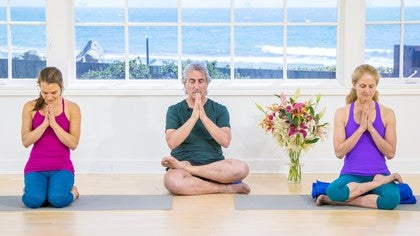Description
About This Video
Transcript
Read Full Transcript
Hi, we're here with Betsy and Ilana, and we are going to work on Viloma Pranayama. Viloma is a modern Pranayama, there's no precedent for this in the older texts. Viloma means something like against the hair or against the grain. Loma is hair or grain, and you'll see why it's kind of an unusual way to breathe. You'll see why it's called that in a moment.
There's various ways to perform this practice, Viloma. The more common way is to count, and we'll demonstrate that one first, and then there's also a possibility of doing Viloma in spaces in the body or in the torso, and we'll do that secondly. So our helpers are sitting, Betsy is sitting in Arda Padmasana, the half lotus. Now we're showing this, but if you decide to do this, you need to be very careful what you do. As always, you need to have the top foot a little bit off to the side of the thigh, so the sole of her right foot is perpendicular to the floor and not parallel, so the sole should be turned up toward the ceiling, and remember when you do Padmasana, the knee should be fairly close together, and if you're going to do Padmasana, it's always useful to do a little bit of a hip opener stretching exercise before you attempt that.
We're putting Ilana in Virasana, the modern version of Virasana, remember that the more traditional version is a slightly different pose, and we've put her on a block as we would for a more beginning student. Notice that when she sits on the block, she's sitting with her sitting bones on either side of the long axis of the block, rather than having the block turned, and also when she comes down into the pose, what I'm going to ask you to do is bring her fingertips into the backs of her knees, really dig them in deep, and then rather than turning the calves out to the sides, I wanted to take her fingertips and stroke strongly back along the calves toward the heels, and pull the calves back away from the knees as she sits down, and that's probably the best way to get into Virasana, very good. So as I mentioned, there's at least two ways to do a Viloma, actually there's more than a couple of ways, there's various ways to do this exercise, but these are the two most common ways. The first one is counting, so I'm going to ask you to start by counting Om One, Om Two, Om Three, and then at that point stop and count Om One, Om Two, and then continue with the inhalation Om One, Om Two, Om Three, and stop, and then again for the pause, count the two, and then continue on in that way until you feel the lungs comfortably full. And then for this particular exercise, we won't do the exhalation Viloma, we'll just exhale the breath all the way out, straight through, without any pauses.
So again, Viloma is against the hair or against the grain, it's a breath that's interrupted, both on the inhales and the exhales, we're only doing the inhales for today, and it's a breath that will help you get a little bit more in touch with your breathing and prepare you for retention for Kumbhaka in the later stages of the practice. So again, this is the counting version of Viloma in which you count up to a certain number, stop, count up to a certain number, continue, so on and so forth. I'm asking the count of three on the inhalation parts, and I'm asking the count of two on the pausing parts. You do not want the pauses to be much longer than the breaths. And so you can continue on in this fashion until you fill up the torso with air, and then you can let it all go.
And at the end of the exhalation, you may want to pause a bit and give yourself a chance to get rested up before you take the next Viloma breath. Now the problem with this exercise, the counting exercise, is that some people find it very distracting to count as they're trying to breathe. So we'll try the second way next, take one more inhalation, both of you please, and then exhale and return to everyday breathing. We'll try a second way, and that is to divide the torso into a three-layer cake. We'll start the breath in the lowest layer of the cake, which is the area between the pubic bone and the navel.
We actually worked on this particular exercise in a previous episode, and that is breathing up on the inhale and down on the exhale. So if we could begin, and if you could take your breath down deep into the pelvis, and with an inhalation, begin to fill up that area between the pubic bone and the navel. And once you reach the level of the navel, stop. Pause briefly, you don't really need to count, but you do need to pause a couple of counts. And then continue on with the second half, or the second part of the inhalation, from the navel to the lower front ribs, and then again pause.
And then finish up from the lower front ribs to the top of the sternum bone, or the clavicles. Very nice. Once you reach that spot, again, we're not doing Veloma exhalation today, we're going to just simply exhale straight down into the pelvis. Take a breath or two, normal breath or two, just to get acclimated, and then again begin from the base of the pelvis, inhale, fill the pelvis to the navel, stop, pause, wait, and then from the navel to the lower front ribs, very good stop or wait. And then finally the third layer of the cake, from the lower front ribs to the top of the clavicles, or to the top of the sternum, if you prefer.
Very nice. And then all the way up, but remember when you exhale in a Pranayama practice, you want to keep that chest lifted very high. Well done, let's just do one more, just to make sure that we've got it set. The breath is started in the base of the pelvis, if that's possible, but as low down as you can find, imaginatively, inhale and come up to the belly button, trying to fill both the front and the back of the torso, pause, one, two, three, or so, inhale from the belly button to the lower front ribs, pause, and then finally from the lower front ribs to the top of the sternum bone, throw it soft as just in a previous exercise. Now inhale on the exhalation, release, very nicely done, go back to everyday breathing.
Now Veloma at first is probably five or six minutes best, and then you can slowly increase the time in this exercise to about six or eight minutes. Eventually then you'll add the Veloma exhalations, but I think it's best at first just to work with the inhales until you establish some kind of consistency with that. So this is Veloma Pranayama, it's a modern version of some very old practices, but it is a modern practice. Thank you.






You need to be a subscriber to post a comment.
Please Log In or Create an Account to start your free trial.